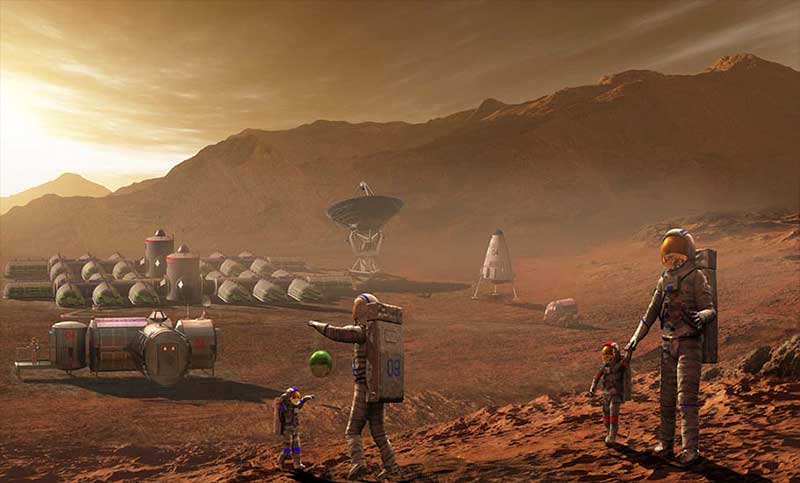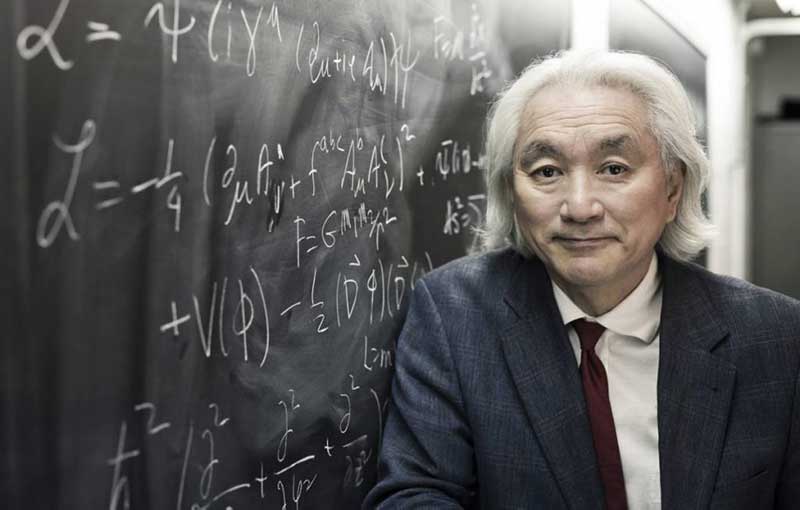- Colonising Mars – a new type of gold rush in outer space
- Future hospitals will resemble body shops
- Programmable matter and shape-shifting technology; it’s coming
- As one planetary civilisation, we will ‘play’ with anything planetary
- Technological singularity – when robots become smarter than humans
Futurist, trendwatcher, bestselling author and theoretical physicist at the City University of New York, Dr Michio Kaku, is almost like a wizard who makes predictions about fantastic technologies that we are close to unlocking. He has been described as ‘today’s Einstein’ and has made it his mission to complete Albert Einstein’s ‘theory of everything’ or string theory – a quantum field theory that would single-handedly explain everything in the universe. Last year, Kaku spoke about the possibility of teleportation and time travel and that, “within the coming decades, we will probably develop something resembling a Harry Potter invisibility cloak.” He also predicted that computers will soon be able to read our minds, giving humans the power to move objects with their thoughts – which is already happening in various forms with mind-controlled bionic limbs.
With developments in nanotechnology, we will soon be able to turn the dreams of ancient alchemists into reality, the ones who tenaciously searched for ways to transform lead into gold. Nanotech gives us the ability to play with materials at their molecular level, enabling us to change them into something entirely different. With advances in biotechnology, we will eventually be able to create new organisms that currently don’t exist in nature and even prolong our own life span. Kaku also envisions that by 2100, international differences will have eventually faded away, turning us into a single, planetary civilisation. By 2050-2060, he says, we will see the start of colonies on Mars.
Colonising Mars – a new type of gold rush in outer space
Humans are going to make it to Mars to make a new home. NASA is involved in it, SpaceX is working on it and Kaku has a few things to say about it as well. According to the famous physicist, we’ll likely have our first basic settlements on the red planet in the 2030s, consisting of structures to provide astronauts with accommodation and life support systems for several months. To get to something really self-sustaining will take a lot more time and effort, however. According to Kaku, 2050-2060 will see the start of colonies, a series of small communities that will have mastered some of the necessities that will enable us to inhabit the red planet independently of resources from Earth. By then, we will have implemented water treatment facilities, put up energy infrastructures and developed greenhouses to grow fruit and vegetables.
By the beginning of the next century, perhaps even by the end of this century, it is predicted that SpaceX will have sent a million people to Mars to establish the first major Martian cities. This will be accomplished over the course of 40 to 100 years and with a fleet of 1,000 Falcon Heavy rockets, each one sending 100 people up. These colonies will eventually create their own infrastructure and wealth and become fully self-sufficient. Think asteroid mining for instance; each small asteroid could potentially contain hundreds of billions of dollars worth of platinum. This could lead to a new type of ‘gold rush’ – this time in outer space.

Future hospitals will resemble body shops
According to Kaku, in the future, our hospitals will resemble body shops. Clearing our body of cancer or getting to our ideal, healthy weight will be just like having a car part replaced or fixed at a vehicle workshop. Patient cells will be used to grow new, healthy organs, replacing whichever part of the body malfunctions. With advances in stem-cell research and 3D bioprinters already printing live tissue, these predictions are not far off.
Other developments like robotic doctors will be common in the near future. These robo-docs, as Kaku calls them, will lead to a substantial decrease in the cost of medical care. Japanese robot nurses are already able to lift patients out of their wheelchairs to put them into bed, and the Da Vinci Surgical System is able to perform complex surgical procedures with incredible accuracy. Then there’s Riba, a robot that looks like a giant teddy bear. It can recognise people’s faces and respond to voice commands while other, even more advanced AI can already recognise people’s emotions! In the future, all that’s left of our doctor may be a software program in a screen on the wall.
Soon, we will have mobile-phone sized MRI scanners that can look inside our bodies. Although most of the current MRI-machines are still room-sized, the smallest MRI scanners in existence today are already as small as a purse. Other medical advances we may see in the near future include DNA sensors in our toilet that can detect cancer from only 100 cancer cells.
Programmable matter and shape-shifting technology; it’s coming
Other futuristic technology we may see within our lifetime – according to Kaku – is shape-shifting or programmable matter (material consisting of minute machines that can be rearranged in various shapes). Already, science is making incredible advances. If we replace atoms with computer chips smaller than a grain of sand and we change their electric charge, they can shape-shift in various ways. These grain-sized chips or catoms are also highly intelligent, as every dot actually has the computer power of a PC. Researchers at Carnegie Mellon and MIT – with support from Intel – are already busy with programmable matter, also known as claytronics. Billions of these catoms together essentially form a network of a billion computers that could create almost any object. According to Kaku, shape-shifting technology could be used to instantly build entire cities. “If I have a clump of clay made of thousands of millions of little dots, I push a button, then the charges rearrange themselves to form a statue, a car, whatever you want. This means that I can push another button and this clay turns into a house or I push another button and a whole city rises out of the desert.”
As one planetary civilisation, we will ‘play’ with anything planetary
The developments that take place over the next century will determine the fate of mankind. According to Kaku, at the moment we are a ‘type zero’ civilisation – we have nationalistic governments and we rely on fossil fuels. In approximately 100 years, Kaku thinks we will have become a ‘type one’ civilisation – a planetary civilisation with global institutions and governments. The Internet is the start of a planetary communication system. English will most probably be the planetary language and the European Union is the start of a type one economy. The entire economic, social and political landscape is changed by discovery, innovation and technology, whereby existing belief systems and prejudices are turned on their heads. Kaku believes that planetary civilisation is the culmination of all these developments and that it is quite possibly the greatest transition in history. He says that in 100 years’ time, we will be controlling what our weather, our volcanoes and our earthquakes do. We will ‘play’ with anything planetary and have the ability to harness the energy output of the earth.
In an interview ‘Will Mankind Destroy Itself?’ on the Big Think website, Kaku discusses the dangers – because there are those, too – of transitioning to a planetary civilisation:
“The danger period is now, because we still have the savagery, but we also have nuclear weapons. So whenever I open the newspaper, every headline I see points to the birth pangs of a type one civilisation. However, every time I open the newspaper I also see the opposite trend. What is terrorism? Terrorism in some sense is a reaction against the creation of a type one civilisation. Now, most terrorists cannot articulate this. They don’t even know what the hell I’m talking about, but what they’re reacting to is not modernism. What they’re reacting to is the fact that we’re headed toward a multicultural, tolerant scientific society and that is what they don’t want. They don’t want science. They want a theocracy. They don’t want multiculturalism. They want monoculturalism. So instinctively they don’t like the march toward a type one civilisation. Now, which tendency will win? I don’t know, but I hope that we emerge as a type one civilisation.”

Technological singularity – when robots become smarter than humans
Taking Moore’s Law (computer technology doubling every 18 months) as a basis, scientists and physicists believe that the technological singularity – when robots become smarter than humans – will take place in 2029. Kaku, however, believes that Moore’s Law will at some point reach a level at which silicon transistors cannot – physically – get any more powerful or any smaller, and in order to keep improving computers, a replacement for silicon will have to be found. He also doesn’t share the sentiments that robots become so smart that they will take control of humans. He says that machines are as smart as insects now, and that they will probably be as smart as monkeys by the end of this century; at which point machines could potentially become more dangerous because they will be able to formulate their own goals and strategies. He recommends, however, that when we get to that point, we simply “…put a chip in their brain to shut them off if they get murderous thoughts.”
Conclusion
The exponential growth in technological advancement has inspired trendwatchers, futurists and physicists like Dr Michio Kaku to make some rather remarkable predictions about our future. Kaku takes complex subjects and transforms them into common analogies; bringing the exciting and incredible new possibilities for humankind into focus. He has written various books and blogs and frequently appears on radio and television such as on the History Channel, the Discovery Channel and the Science Channel. His three New York Times best sellers are Physics of the Impossible (2008), Physics of the Future (2011) and The Future of the Mind (2014).
Share via:


